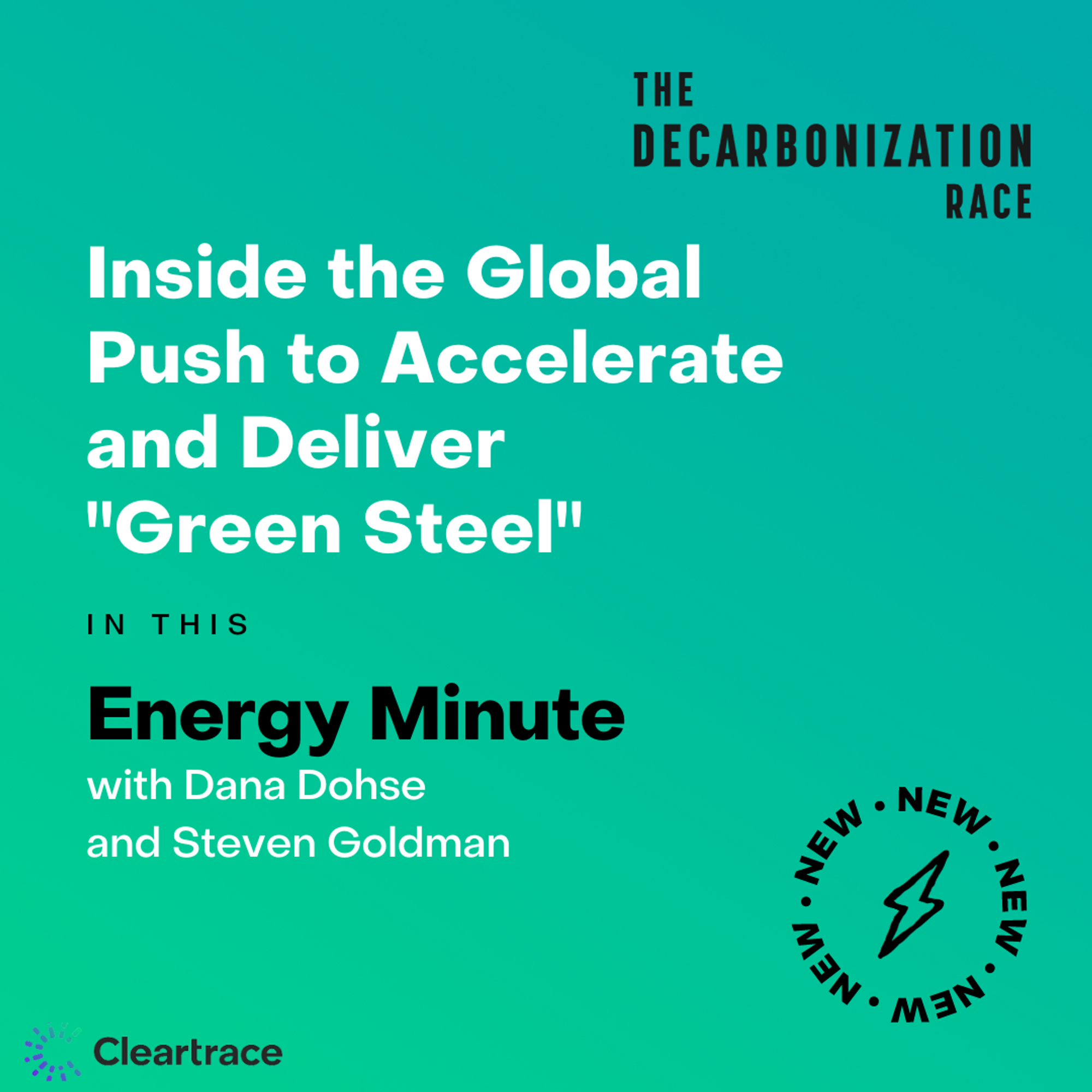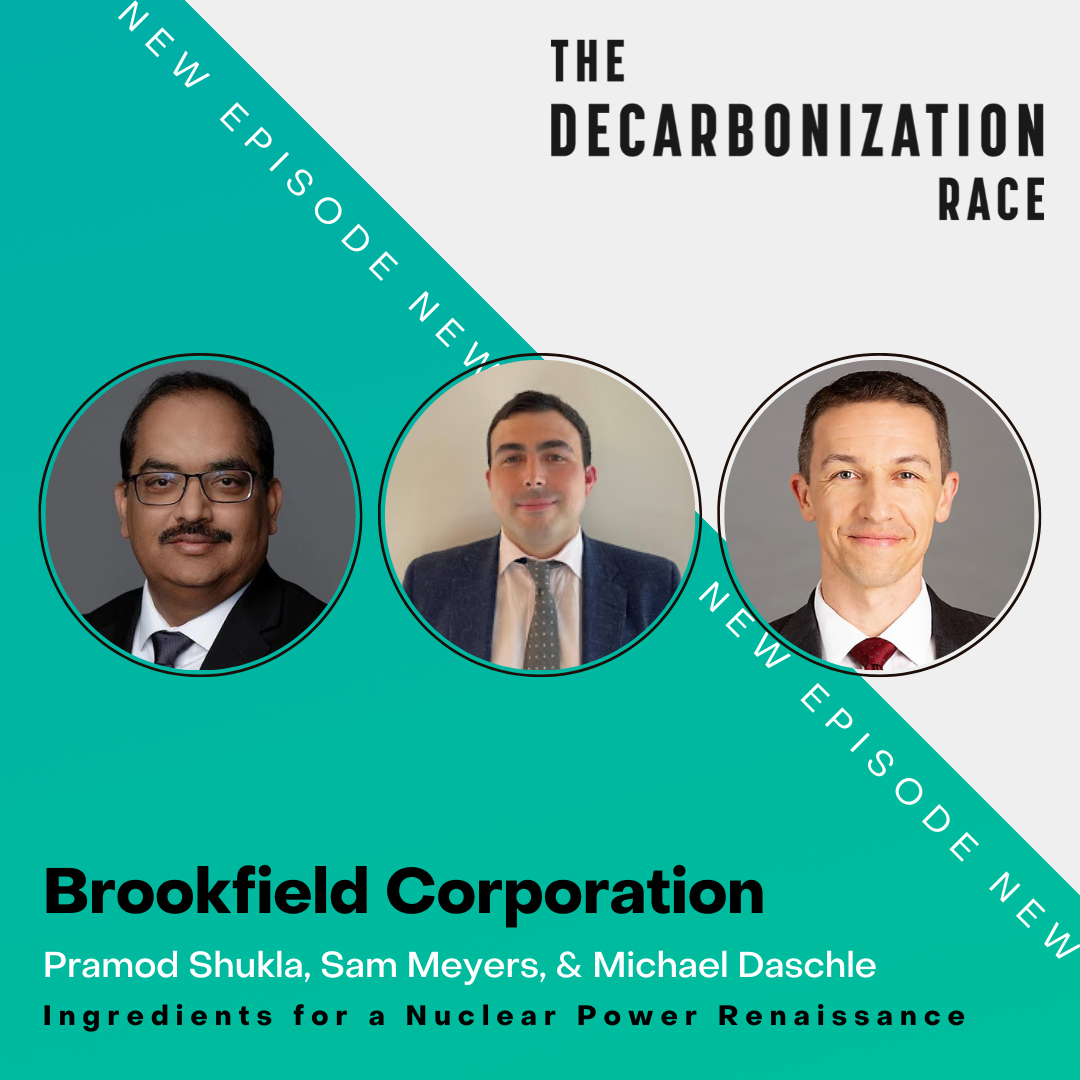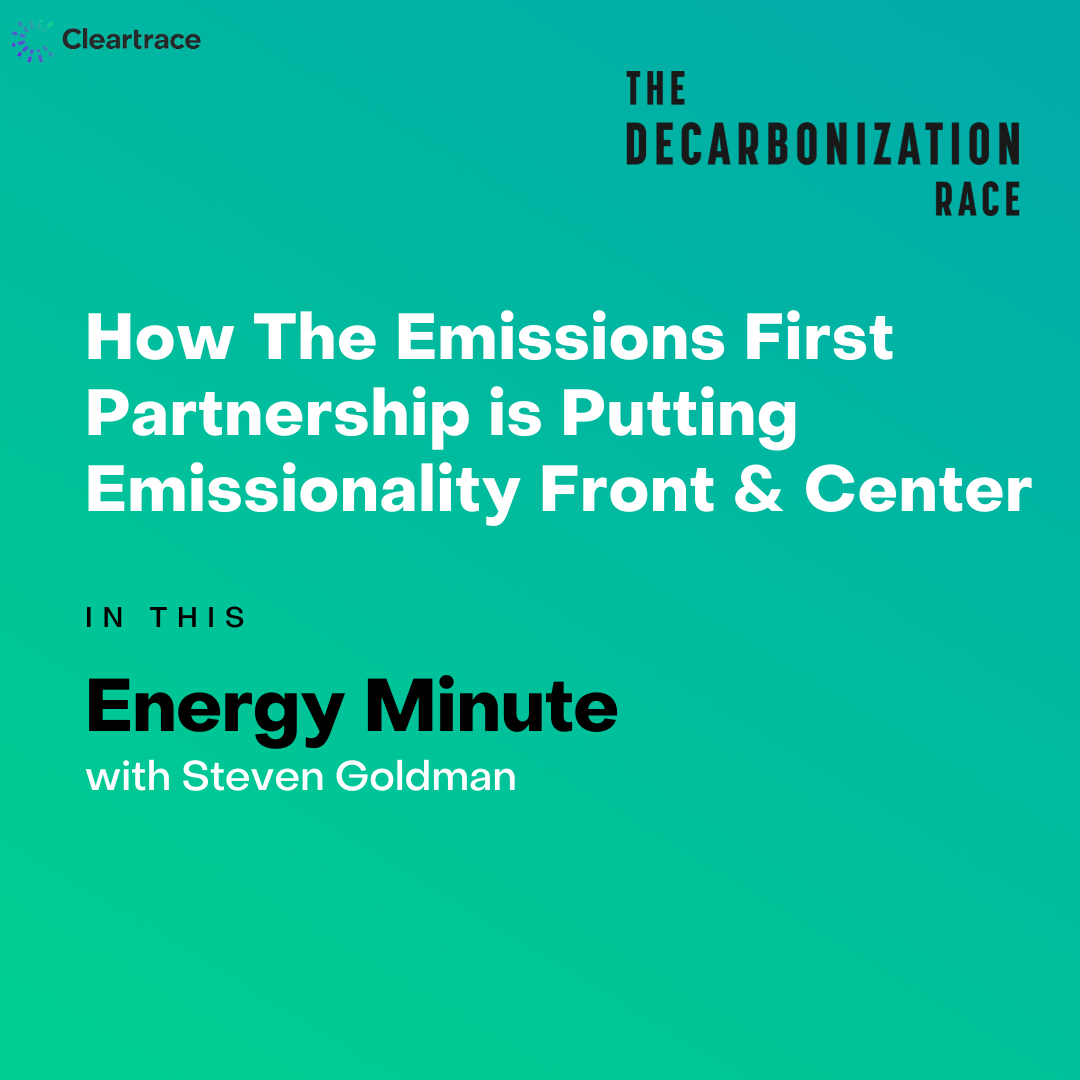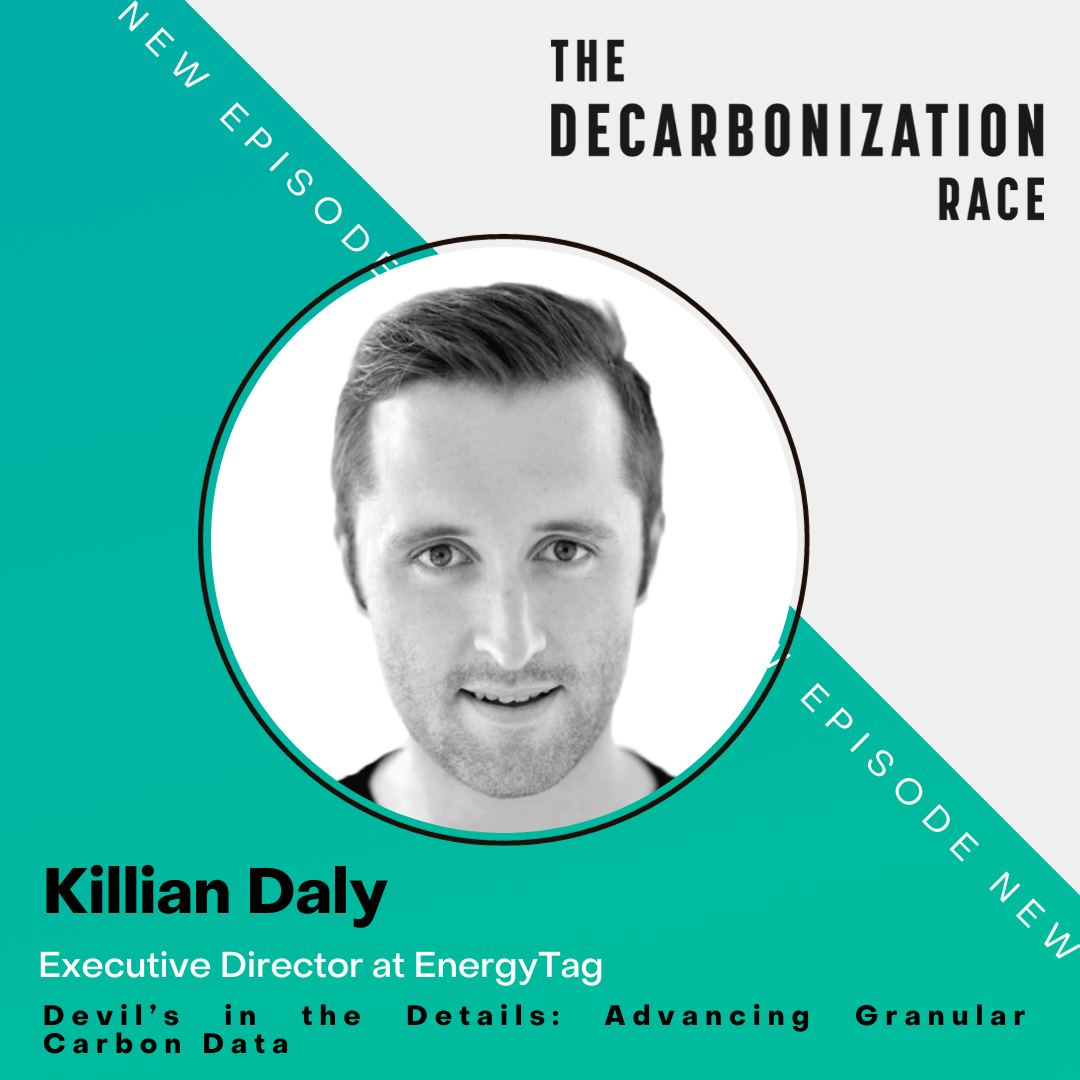Energy Minute: Inside the Global Push to Accelerate and Deliver “Green Steel”
As more and more industries are pushing to decarbonize their processes - and in the process, help curb emissions for companies’ supply chains - green steel is trending. Automakers, builders and companies in a range of other sectors are under pressure to reduce the embodied carbon in their products. But delivering “green steel” means both changing processes that have been in place for decades, and agreeing on what constitutes zero-carbon or near-zero carbon steel. In this Energy Minute, co-hosts Dana Dohse and Steven Goldman delve into the push for green steel - what’s driving it, where early demand is coming from, what process changes are making significant cuts in steel’s embodied carbon emissions possible, and the big challenges ahead in taking green steel to sufficient scale.

As more and more industries are pushing to decarbonize their processes – and in the process, help curb emissions for companies’ supply chains – green steel is trending. Automakers, builders and companies in a range of other sectors are under pressure to reduce the embodied carbon in their products. But delivering “green steel” means both changing processes that have been in place for decades, and agreeing on what constitutes zero-carbon or near-zero carbon steel.
In this Energy Minute, co-hosts Dana Dohse and Steven Goldman delve into the push for green steel – what’s driving it, where early demand is coming from, what process changes are making significant cuts in steel’s embodied carbon emissions possible, and the big challenges ahead in taking green steel to sufficient scale.
Key Takeaways
- Emissions from steel making are representing, depending on estimates, between 6-8% of global emissions – a big slice of the planet’s global carbon footprint. The manufacturing of iron and steel is on track to consume 50% of the total remaining carbon budget to meet a 1.5 degree target by 2050.
- Using hydrogen instead of coal as a reagent to reduce iron ore to pig iron – the key feedstock in refined steel – is one pathway to create green steel, reducing the CO2 emissions compared to the equivalent process in a traditional blast furnace.
- Sweden’s H2 Green Steel is looking to cut emissions from its production of green steel by 95% through the use of green hydrogen as a reagent, compared to coal in traditional steel making. They plan to source the electricity required for hydrogen production (via electrolysis) and plant operations from nearby renewable sources, including hydropower from the Lule river and wind farms in the region.
Resources
- Startups mentioned in this segment: Boston Metal, Electra, Hybrit, H2 Green Steel
- Background on the First Movers Coalition and its sectoral approach to decarbonization: https://www.weforum.org/impact/first-movers-coalition-is-tackling-the-climate-crisis/
- China Baowu and Rio Tinto’s decarbonization alliance: https://www.spglobal.com/marketintelligence/en/news-insights/latest-news-headlines/china-baowu-joins-decarbonization-alliance-rio-tinto-invests-in-battery-startup-67679175
- Rocky Mountain Institute blog post, “Forging a Clean Steel Economy in the U.S.”: https://rmi.org/forging-a-clean-steel-economy-in-the-united-states/
Transcript
Dana Dohse: Welcome to this week’s Energy Minute, brought to you by Cleartrace. I’m Dana Dohse.
Steven Goldman: And I’m Steve Goldman.
Dana Dohse: Last week on the show, Cleartrace’s CEO, Lincoln Payton, spoke with Blaine Collison from the Renewable Thermal Collaborative on how a big part of the decarbonization race hinges on decarbonizing heavy industries. In this week’s Energy Minute, we’re going to take a look at one of them in particular, the push to create green steel.
Steven Goldman: Demand for green steel is coming from a range of directions. There’s been a range of significant corporate commitments to procure green steel, in particular, to help automotive manufacturers deliver on their promises to reduce the embodied carbon of their products.
Dana Dohse: And a handful of startups are benefiting from the backing of those auto giants, trying to make the electrification technologies and hydrogen a bigger part of steelmaking process.
Steven Goldman: But at its root, this represents a fundamental shift in steelmaking processes on a global scale. So today, we’re going to delve into the concept of green steel, the changes in the processes that make it possible, and the big challenges ahead in taking green steel to sufficient scale.
Dana Dohse: All right, let’s get into it. I guess starting with steelmaking, why is this a big deal? Why is this something we need to decarbonize in the first place?
Steven Goldman: From the figures I’ve been reading, emissions from steelmaking are representing, depending on who you ask, between 6% and 8% of global emissions. So it’s a very significant slice of the global carbon footprint. My understanding is that right now, the manufacturing of iron and steels is on track to consume 50% of the total remaining carbon budget to meet a 1.5 degree target by 2050. So the process of making steel and shaping it into the right geometries, it requires high temperatures, intensive energy consumption, and in many cases, it’s coming in the form of fossil fuels, meaning coal. You have to break the chemical bond in iron ore to get access to pure iron. It’s a reaction that requires a reagent for it to bind with oxygen. And broadly speaking, that reagent for the last 2,000 years has been coal and it generates CO2 as a byproduct.
Dana Dohse: So steelmaking, really hot, 1,200 degrees Celsius and above, and the process can be broken into three steps. First is reduction, second, transformation, and third, forming. In the first step, the oxygen in the iron ore is separated from the iron to produce pig iron. Then this pig iron is alloyed with other materials such as nickel, chromium, manganese, molybdenum to create a crude steel material with the physical properties required in the final application. And finally, the steel is formed through a series of hot and cold processing steps into the final shape the customer will use.
Steven Goldman: All of these steps are energy intensive, but the bulk of the CO2 emissions really comes from reducing iron ore in that first part of the process. It’s been really interesting to watch the different technologies that companies have been looking at as a possible way to bring those emissions down. To create what’s being called green steel, it’s theoretically making steel without the use of fossil fuels and there’s no clear definition yet for what’s going to constitute that.
Dana Dohse: As companies around the world race to reduce the greenhouse gas emissions associated with their operations, services, and supply chains, lowering the embodied carbon of steel is one of the world’s biggest challenges. So what is green steel? Green steel, theoretically, is the manufacturing of steel without the use of fossil fuels. The challenge is that there’s no widely accepted definition for what that constitutes.
Steven Goldman: I’m quoting from GreenBiz here that globally, right now close to three quarters of virgin steel is produced in blast furnaces that are fueled by coke, which is cooked coal, limestone, and iron ore. But the dominant method in the US oddly is electric arc furnaces according to the American Iron and Steel Institute. The largest US steelmaker, U.S. Steel, they’re actually making a big bet on electric arc furnaces. They’re even selling a product line called verdeX that is being produced using a quarter of the carbon intensity required for comparable products. As we were doing the research for this segment, it’s been interesting to see that the EU steelmaking emissions actually are quite higher than the US’, which is not what one would expect given the US has really plentiful supply of coal.
Dana Dohse: There’s a wide range of ways that manufacturers are working towards curbing steel’s carbon load. The first of which is electrification. So this is shifting production from that traditional blast furnace that we talked about to an electric arc furnace. But this is dependent on the furnace being powered by renewable sources. So you need green energy coming from the grid or through power purchase agreement or the range of topics we’ve discussed on this podcast. Otherwise, the steel wouldn’t be green.
Steven Goldman: The other difficulty with that is that electric arc furnaces, bringing those into steelmaking facilities, it only reduces emissions for part of the process, the carbon impacts of transforming and shaping the metal. But it requires you to already have an already reduced source material, meaning that pig iron that we discussed before.
Dana Dohse: So that’s really looking at that upstream implications of your steel.
Steven Goldman: Exactly. The other issue is right now, what steel manufacturers are looking at is they need that feedstock in order to feed the remaining parts of the process. The way that you would make that today would be recycling scrap steel back into the system because then you have a shorter and less carbon intensive process overall. But the supply of recycled scrap steel right now isn’t currently anywhere near large enough to take the place of the current primary steel production demand.
Dana Dohse: In an additional challenge in a report by the Global Energy Monitor at NGO that covers this topic, they say that the adoption of the technology has slowed and it’s nowhere near enough to help meet current targets. 31% of steelmaking capacity uses electric furnaces, but only 28% of capacity under construction will use this technology.
Steven Goldman: Yeah. So one view on that is that we have the technology today to move the industry forward, but part of it is that we need this installed in more and more foundries around the world.
Dana Dohse: Another way that different companies are looking to green steel is carbon capture and storage. This is taking the traditional steel process and integrating carbon capture on the back end at the blast furnace site to sequester that carbon production from the existing production that’s already happening. So pretty simple solution in terms of the changeover, but not so simple in terms of actually getting that technology to scale.
Steven Goldman: It runs into the same issues that carbon capture and storage has been having in other parts of the world and other industries, which is you need facilities that you can actually store that carbon for a prolonged period of time, which sometimes requires geologic formations nearby or some other technological solution in terms of storing and compressing the CO2 down or transporting it as a feedstock for other chemical processes.
Dana Dohse: That’s why there are so many different processes being explored. The next of which is molten oxide electrolysis or MOE. It’s a competitive zero carbon technology that allows iron ore reduction using electricity instead of coal.
Steven Goldman: It’s also running parallel to the other major one that’s being looked at very closely right now, which is hydrogen-based direct reduction, so using hydrogen instead of coal as that reagent to reduce iron ore to pig iron. What that’ll do is eliminate the CO2 emissions from the equivalent process in a traditional blast furnace that yields the feedstock that then gets transformed and shaped.
Dana Dohse: Right. But the challenge here is that it’s really energy intensive. Direct reduction requires an electric arc furnace to heat up the reduced iron from the consecutive process steps, and the production of hydrogen itself requires a significant amount of electricity, which in turn might emit CO2 depending on the structure of the grid supplying the electricity.
Steven Goldman: What’s interesting is that studies are showing that a current grid average emission levels, the increased electricity use, and the resulting emissions for hydrogen production, and running an electric arc furnace are offsetting the emissions reductions from fuel switching from coal. So you end up with emissions levels from steel production that are running roughly on par with blast furnace produced steel. That means that they’re running on par, these two processes based on whatever level of resource mix you have on the grid today. That means that as we decarbonize grids around the world that steel facilities are attached to, if you’ve moved to an electrified process, then every time you add renewals in that grid, you’re bringing the emission factor down that’s feeding into that facility.
Dana Dohse: This is similar to a lot of other markets we’ve talked about on the podcast, and it’s an early market. This technology is nascent. It’s developing. We’ve got some great projects going. The question comes down to what’s the appetite? What are corporations willing to spend on green steel and how big is this market?
Steven Goldman: The organization we’ve seen that’s really been at the forefront of this is the First Movers Coalition, which as a total organization, it’s roughly 55 companies in nine countries that have committed to purchasing a proportion of the industrial materials and transport that they need from suppliers using near zero or zero carbon solutions. Dana, I think you heard them talk at the VERGE Conference this past fall.
Dana Dohse: I did. The First Movers Coalition is super interesting because they’re not just looking at steel, they’re looking at a wide range of industries. It’s actually across seven sectors that are super critical to decarbonize steel, aluminum, concrete, trucking, shipping, aviation, and CO2 removal.
Steven Goldman: So with the coalition on steel, the coalition members have committed to purchasing volumes of near zero emission steel by 2030. There’s breakthrough iron in steelmaking technology that’s needed to deliver that. We’ve discussed most of these so far that are what would be considered near zero or zero carbon steel under that criteria. What the steel purchasers are setting is a target that at least 10% of their annual steel procurement volumes by 2030 have to meet or exceed the first mover coalition definition. But it’s interesting, there’s a really fascinating mix of companies that are taking part in this. It’s obviously automotive companies as we talked about, like Ford Motor Company, Volvo Group are both involved. But then you have companies that are working to produce hydrogen like Enel and ENGIE and the Fortescue Metals Group. You have renewable energy suppliers who also are off-takers of steel because they have to build wind farms and solar farms, who have to put up other facilities that are going to use steel in the process, [inaudible 00:10:35], renew power. Then you have technology companies like Trane and Ecolab.
Dana Dohse: But let’s be clear here, we’re talking near zero emissions. Because of all the challenges we’ve just talked about, it’s a really tough sector to decarbonize.
Steven Goldman: The standards are still being proposed at this point. The German Steel Federation has just started putting forward the broad outlines of what a definition for green steel or zero carbon steel would look like. Across other sectors, we’re trying to do the best we can essentially. But everyone is looking at the problem and saying, A, we have off-takers who want to buy green steel to meet their net-zero commitments and specific goals they’re setting on low carbon or zero carbon steel adoption, but then you also have the producers who have to be able to supply that. There’s already a significant amount of movement happening in this space, Tata Steel from India, ArcelorMittal. You’ll hear that name a lot as we keep moving through this. SSAB already have pilot green steel production sites up and running. ArcelorMittal ThyssenKrupp, Salzgitter, H2 Green Steel, and British Steel have all announced plans for full-scale green steel production facilities that are supposed to come online in the EU between now and 2030.
Dana Dohse: Yeah. Nippon Steel is also planning a green steel production in Japan.
Steven Goldman: And China’s moving too, right?
Dana Dohse: Baowu will begin the construction in mid-February ’22 of a new green hydrogen fuel electric arc furnace. The project is scheduled to be completed by the end of 2023. It will be the first zero carbon electric arc furnace produced by Baowu. Additionally, in November 2021, the company unveiled a Global Low-carbon Metallurgical Innovation Alliance and a fund that will put five and a half million towards the low carbon metallurgy research, including hydrogen. The alliance is a force to be reckoned with.
Steven Goldman: The Global Low-carbon Metallurgical Innovation Alliance, it’s a really powerful group of companies that’s being assembled around 60 members in 15 countries. It’s including steel companies, again, ArcelorMittal, Shougang Group, as well as mining companies such as BHP Group and Rio Tinto. What’s interesting though is ArcelorMittal’s name keeps popping up. They’ve been doing a range of investment in innovation for different parts of the green steel supply chain, and that’s showing up in the form of startup funding. One in particular that’s US-based is Boston Metal, who raised 120 million in a series C round that was led by ArcelorMittal, who themselves invested 36 million. They’re working on the number of applications for emissions-free steel, metal production that are building off of one of the processes we discussed before, molten oxide electrolysis, which is using renewable electricity to convert iron ore or other feedstocks into a high purity liquid metal. But what’s interesting with them is that’s feeding back into the automakers that we were talking about before.
Dana Dohse: Right. One that’s really caught my attention is H2 Green Steel. They are using hydrogen created by renewable electricity to fuel its process, and it just got funding from Just Climate. They’re a climate tech fund set up by Al Gore’s Generation Investment Management. H2 Green Steel claims it will begin producing Europe’s first green steel using hydrogen, making it carbon-neutral, and they’re doing this in northern Sweden with the goal of being launched by 2025. So it was spun off by Northvolt, which makes batteries to power the energy transition as the company sought more of sustainable steel to use during its manufacturing.
Steven Goldman: Northvolt’s a really interesting player in the mix as well as they’ve been working to make what they’ve claimed as the world’s most environmentally sustainable batteries targeting both stationary storage, which I know we’ve talked about on the show before, but also for EVs. The idea that they’re now also reaching up the supply chain into steel and trying to decarbonize that sector with a spinoff is also really interesting.
Dana Dohse: And they’re producing steel using a direct reduction reactor in the place of a blast furnace. So they’re producing sponge iron and water. The electricity required for electrolysis in the running of the plant will be provided by nearby renewable sources, including hydropower from the Lule River and wind parks in the region. The promise is to cut emissions by 95% when compared to traditional steelmaking. So that’s something to get excited about.
Steven Goldman: Definitely. And Sweden’s turning into a bit of an epicenter for this as well. There’s another venture called Hybrit that’s owned by steelmaker, SSAB, and Vattenfall and LKAB, which is a mining consortium. They started shipping their first green steel output made using renewable energy and hydrogen to Volvo in mid-2021 for prototype vehicles and components. Their plan is to get to full scale production capacity in their first factory for Volvo by 2026.
Dana Dohse: Another one that’s caught my attention is Electra, which is backed by Amazon and Breakthrough Energy Ventures, as well as Nucor, the largest user of electric arc furnaces and a major steel scrap recycler, which is, as we mentioned, the key feedstock needed along with the use of EAFs. They are also a member of the Global Steel Climate Council, which is an industry group that is advocating for a single global standard for green steel that considers total emissions generated regardless of the production method.
Steven Goldman: And that’s the theme that keeps coming up, is everyone’s looking around to say, “Okay, what is the core global standard that we should be looking for? Is it based on the product? Is it based on the production method? Is it based on some other metrics that they should be looking at that basically serve as a certification scheme for what they’ve done?”
Dana Dohse: Exactly. We’re seeing some developments, particularly in the US with the passage of the Inflation Reduction Act. How does that really play into the adoption of greens steel in the US?
Steven Goldman: I think Michael Panfil, who was on our last Energy Minute, would have a lot to say here, but I pulled a little summary about it. Basically, the Inflation Reduction Act put the right mechanisms in place that a steel producer or a steel producer working with an independent power producer could stand up a solar wind project. They can take direct value related to the power that’s being developed through that project. They can use the electricity that the wind or solar project is generating to produce clean hydrogen, and then they can receive the section 45V hydrogen production tax credit for the production of green hydrogen that facility produces. So whether they produce it themselves or they rely on a third party supplier, that tax credit for hydrogen production is likely going to be a driver for green steel because so many steel producers are looking now at using hydrogen to replace coal and this would help them have a more attractive business case for that shift.
Dana Dohse: So if we think about the cost curve with new technologies, this is yet another way that the government is incenting this new market to develop by making that cost even more accessible. It’s just another tool in the tool belt for driving decarbonization.
Steven Goldman: And it’s going to be interesting to see how it plays out, because if the US can get the right leg up with the technology adoption, then they could be in a better position to decarbonize actually faster than the EU depending on who gets themselves in place regarding hydrogen faster. Overall, it’s a fascinating transition. It’s definitely something we’re going to keep a close eye on and probably do some future segments on.
Dana Dohse: Absolutely. I’ve got my eye on how are we going to prove green steel, what are the requirements of it, and how is that going to play out because that will really be the lynchpin behind all of this technology.
Steven Goldman: It’s going to be proof of decarbonization. It’s going to be provenance, being able to provide the supply chain data going back upstream, and then as people go to prove out what energy they’ve used to produce hydrogen to feed into the feedstocks, all of that has to have data behind it.
Dana Dohse: Thanks for joining us for this week’s Energy Minute. For more of the latest news in sustainability and decarbonization, visit cleartrace.io.










